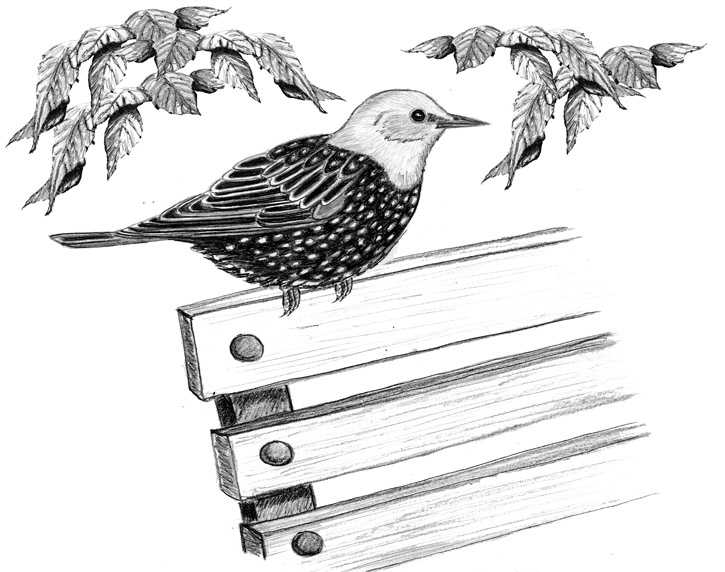
Dear Bird Folks,
My sister-in-law (from New York) sent us the attached photo of a bird that was taken in Central Park. Her husband thinks it’s a starling, but my own husband disagrees. I tried to look it up in my bird book but found nothing that came close. Can you help?
– Janet, East Sandwich, MA (P.S. I hope you can open my photo. I’m rather tech challenged.)
You did fine, Janet,
Your emailed photo came through loud and clear. Well, not actually loud. After all, it’s just a photo. But it’s most certainly clear. So, let’s take a look. First, give me a second while I put on my glasses. Eyeglasses are something new I have been (grudgingly) using lately. I keep telling everyone at work that I don’t need glasses, but I’m starting to have second thoughts. Apparently, I’ve been giving customers change for fifty-dollar bills when they only hand me a five. This also explains why so many customers insist that I personally wait on them. And I thought they just liked me. I should have known.
The bird in your photo is a European Starling that is going through the “change.” (Relax it’s not what you think.) Earlier this summer I wrote about fledgling birds that were transitioning into their adult colors. This transition is brief and thus isn’t included in many bird books. That explains why you couldn’t find a matching image in your book. But since I have more bird books than the Library of Congress, I had no problem tracking it down. After consulting my books, and putting my glasses on, I’m convinced your mystery bird is indeed a starling…either that or it’s a fifty-dollar bill. I’m still not comfortable with the glasses.
Some birds, like chickadees for example, look exactly the same from the moment they leave their nest until the day they pass away and make the long journey to the big bird feeder in the sky. Goldfinches, in particular the males, have two options. They look rather plain in the winter, but will turn bright yellow come spring. The starlings’ colors are more complicated. When they first leave the nest they are drab gray. The grayness lasts until the end of summer when the birds molt into their fall plumage. In the fall, starlings both young and old feature the speckled look we are all familiar with. There is, however, a weird in-between plumage that young starlings briefly have. For a short period only their bodies are speckled while their heads remain gray, as if they’re wearing gray hoodies, like Bill Belichick…only without the scowl. Eventually, though, the birds will look just like their parents and that will be the end of their plumage transformation. Wait! I lied. It turns out the starlings’ transitioning still hasn’t ended. There are more changes in store. Wanna know what these changes are? Read on for the next exciting installment of As the Feathers Turn – the Starling Edition.
At the end of each summer starlings, like many birds, grow a fresh batch of feathers. These new feathers have white tips on the ends and it’s these white tips that give them the aforementioned speckles. The speckles stay with the birds for most of the fall and into the winter; but when spring arrives the birds are sporting a shiny, greenish-purple plumage and their speckles are mostly gone. And here is the interesting part (well, sort of interesting): The birds have somehow lost their speckles without losing a single feather. Starlings go through what is known as a “wear molt.” Over the course of the winter the white feather tips wear off, revealing a much more attractive greenish-purple coloring underneath. How about that? Now I’ll bet you are glad you continued to read.
With a North American population of perhaps 200 million birds, you might think folks would be fairly familiar with starlings. However, like House Finches vs. Purple Finches, many of my customers regularly confuse European Starlings with Common Grackles. Part of the problem is that both starlings and grackles appear dark from a distance, and both birds travel in flocks and will invade our birdfeeders in large numbers. But the key difference is that grackles don’t have spots of any kind. Spots are totally a starling thing. Also, grackles are much larger birds and have freaky yellow eyes, while starlings have dark eyes. But in the summer, starlings have yellow beaks, while grackle beaks are always black. Finally, grackles have nothing to do with Eugene Schieffelin. Who is Eugene Schieffelin, you ask? Oh, don’t act like you don’t know. Eugene Schieffelin, is the person who, in 1890, brought the first starlings to the United States. And where did he release these imported birds? That’s right, NYC’s Central Park. Therefore, the starling in the photo your sister-in-law sent could be a direct descendant of one of Eugene’s released birds. How cool would that be? Perhaps not as cool as being a descendant of the Mayflower, but in the bird world it’s pretty close.
Tell your husband that your mystery bird is indeed a starling, Janet. Since being released in 1890, starlings have spread throughout the continent and have caused significant environmental problems, but that’s another column for another time. The takeaway here is that starlings have speckles (and sometimes gray hoods) and grackles have yellow eyes. I’d write more on this subject but there’s a line of people standing in front of me and they all want change for “fifty–dollar bills.” Ha! They don’t know I bought glasses.